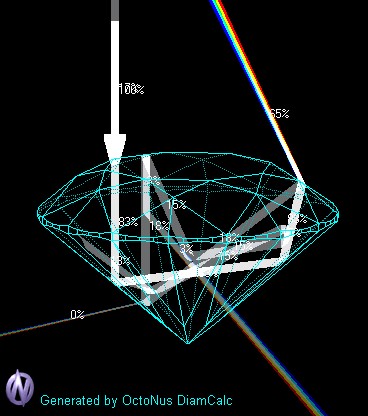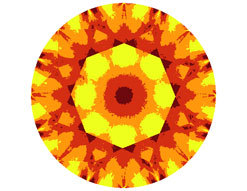This page contains references to diamonds or engagement rings from different companies. Sometimes I do receive a commission when you click on links and buy the products.
If you are in the market for a diamond, it is likely you will have heard a myriad of technical terms being thrown out there, and close to the top of the list will be diamond fire.
Diamond fire is an optical attribute which, along with diamond brilliance, indicates the sparkle of a diamond. Although ultimately concerned with the same optical aspect of a diamond, brilliance and fire are not interchangeable. In the most basic terms, brilliance is the brightness of light and scintillation (white light), whereas fire is the dispersion of white light into rainbow colours through refraction (rainbow light).
A good way of grasping the basics of diamond fire is to compare a real diamond to moissanite (a synthetic gemstone sometimes used a diamond-substitute). Diamonds and Moissanite have very similar properties and it can be difficult for the untrained eye to tell them apart. When offering guidance on distinguishing a diamond from Moissanite, it is often recommended that the viewer focus on the fire on the stone.
As you can see from this image, moissanite has a greater fire dispersion than a diamond, but a lower brilliance. The result is that a moissanite stone can have a ‘disco-ball’ appearance, with an abundance of rainbow light that is not balanced with white light. By contrast, a high-quality diamond will present an intense fire but display an equal level of brilliance to give a clear, bright white sparkle.
Understanding the Basics of Light
Visible light is part of a spectrum made up of electromagnetic energy. This energy travels in waves. White light is comprised of multiple wavelengths, with each of these presenting and corresponding to a specific color. This rainbow of colors can be seen when the white light waves enters a transparent substance such as glass, water or a diamond. This is because when the light enters one of these transparent forms, the speed which it is travelling at is slowed down significantly. This slowing causes the light to bend (refract). When the light exits the transparent material back into open air, its speeds up again. The different wave lengths are refracted at different rates; this causes them to become separated (dispersed). It is this phenomenon that allows us to see a rainbow in the sky, the rainbow of colors refracted from a prism, and, of course, fire from a diamond.
The Effect of Fire
White light travels at 186,000 miles per second through air until it enters a transparent material such as water or a diamond and is slowed down. The more the light is slowed, the greater the material’s ability to refract the light. A material that is highly efficient at slowing and refracting the light is described as having a high refractive index. A diamond has a refractive index (RI) of 2.42, where as an Emerald has a refractive index of 1.58. The higher the refractive index, the greater the potential for light dispersion. As a diamond has such a high RI, it possesses the ability to display an intense fire, however this potential can only be reached with a high-quality diamond that has well cut.
Fire brings depth to a diamond and is what gives a diamond a its ‘hypnotic’ optical properties. This spectrum of rainbow light is intrinsically linked with our perceptions of something special; something almost magical. Like a rainbow after a storm, fire within a diamond seems to be an impossible miracle of nature, when it is in fact the result of deliberate precision in the cutting process. That is why fire is such an important feature in your diamond.
The Importance of Diamond Proportions
The amount and exact location of light dispersion within a diamond can be assessed using a technique called ray tracing. Ray tracing involves directing a laser through a diamond and following the beam of light as it travels through the diamond and out the other side. Ray tracing allows to calculate the location of dispersion of the light that is being returned to the eye. There is a narrow range of basic proportions that will result in fire being generated within a diamond.

The Importance of the Light Source
In order to observe fire within a diamond, the diamond must be lit under proper lighting conditions. Not all lighting environments will release fire within the stone.
Singular sources of direct light in a small angular size are the most efficient at producing fire and large light sources are the least efficient. Looking at your diamond in direct sunlight will allow the diamond to exhibit good fire, however any intrusion or diffusion of this light source (such as cloud cover) will drastically reduce the appearance of fire.
Indoor lighting that adopts a number of individual lights can also create an excellent light environment for observing fire. You will notice that many bricks and mortar jewelers use LED overhead lights. These lights will often be in sets of three and can be adjusted to different angles. This allows the sales person to creating the perfect lighting environment; one which is most flattering to the diamond. This form of small angular size lights is used in restaurants and shops across the world giving you all the more opportunity to view your diamond in all its fiery glory.
However, any light that is being diffused (for example, strip lighting that is in plastic casing) will suppress the fire within your diamond and therefore is not a good environment for making assessments pertaining to fire.
The Importance of the Observer
The observer’s ability to perceive colored sparkle (fire) is influenced by a number of factors. The first of these is quite simply their distance from the diamond. Generally speaking the larger the diamond, the further away the observer will be able to be and still view fire. However, it also depends upon the observer’s pupil size (how dilated their pupil is) as the fan of dispersed light falls across their pupil, and a specific color gets clipped from this fan. Pupils will dilate (get bigger) in a dimly lit environment. As a beam of dispersed light exits from the diamond, each of the wavelengths will have different trajectories; this causes them to fan out at a greater distance, which increases the chances that they can be clipped.
So, if you are sat in a dimly light space (for example a candlelit restaurant) it may be possible to observe fire from a diamond that is a few tables away, as large chromatic flares have more chance of falling across your dilated pupil.
The Importance of Faceting Precision and Virtual Facets
You may be familiar with the term facets, but virtual facets? Well these are the areas where the real work of light performance takes place. Virtual facet describes an area of the diamond that reflects light back to the eye. There are many more virtual facets within a diamond than there are physical facets, as a single facet can reflect light rays from more than one source and from multiple directions. The larger these virtual facets are, the more likely it is that a fan will be large enough for a single wavelength to be clipper by the eye of the observer.
To perform effectively and unleash fire, facet designs must include some larger virtual facets and precise facet alignment is essential in making sure the facet sizes prescribed by the design are accurately and precisely produced; if not, the design will be broken up by very small virtual facets which are low performing and give a chaotic pattern. Cut and polish are both important to light dispersion. The facets must be accurately crafted and polished to give a flat, mirror finish in order to produce an intense fire.
Lab Grading of Fire
The only source for a reliable, scientific evaluation of diamond fire comes in the form of the light performance grading system developed by AGS. A 3-D scan of the diamond is ray traced and the effects of 32,000 rays are calculated. After this data has been collected, the diamond is graded for contrast, brightness, light leakage and dispersion. Grade 0 denotes ideal, and is only given is there are no significant deficits.
You may have come across ASET light maps; these maps are generated from the AGS light performance analysis and show light return, light leakage and contrast. The AGSL system can also produce fire maps, which indicate the areas of the diamond which are capable of producing the optical property of fire.

The Final Word
Fire is an integral part of the beauty we except from our diamonds. It brings a magic and sparkle of color and warmth to the icy white scintillation and brilliance that a diamond delivers.
The only way to ensure your diamond will present an intense fire, is to look for diamonds with light performance images and HD videos – read my detailed article on that here.

Richard Jenkins, The Diamond Guru
Get free assistance from the Diamond Guru today. You’ll be glad you did!
- Secure the best quality diamond for your budget.
- Don’t pay over the odds for your diamond ring.
- Have piece of mind that you didn’t get ripped off.
Have a Question? Contact us now…

